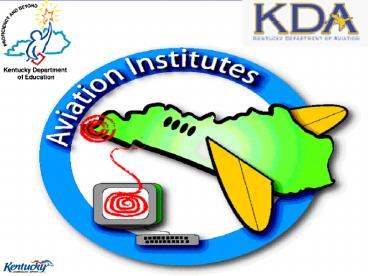Principles of Flight - PowerPoint PPT Presentation
1 / 46
Title:
Principles of Flight
Description:
What type of drag is exhibited by a parachute? Parachutes on a 747. Parafoils. Planes and Parachutes. Cirrus only one certified. Lets Build and Airplane!! Activity ... – PowerPoint PPT presentation
Number of Views:2218
Avg rating:3.0/5.0
Title: Principles of Flight
1
(No Transcript)
2
Principles of Flight-Aerodynamics
- Sean Howard
- KY Dept. of Aviation
3
What makes and airplane fly?
4
Ingredients for Flight
- Bernoullis Principle
- Newtons Laws of Motion
- Inertia
- Energy
- Velocity and Acceleration
- Three Dimensional Movement
- Stability and Controllability
5
Atmospheric Properties
- The atmosphere is a fluid and exhibits fluid
- properties.
- Many of the principles of fluid dynamics apply
- to the atmosphere.
- Bernoullis principle
- Non-Compressibility
6
Parts of an Airplane
Activity
- Cockpit
- Fuselage-Spindle Shaped
- Wing
- Flap
- Aileron-Little Wing
- Empennage-Feather the Arrow
- Stabilizers
- Rudder
- Elevator
- Engine
7
Four Forces of Flight
8
Lift
- Lift is an aerodynamic force
- Lift must exceed weight for flight
- Generated by motion of aircraft through air
- Created by the effects of airflow past wing
- Aircraft lift acts through a single point called
the center of pressure.
9
Two Possible Explanations
- Bernoullis Principle
- Newtons Third Law
- http//www.grc.nasa.gov/WWW/K-12/airplane/bernnew.
html - Aviation institute Teachers Guide-Anderson
Eberhardt, The Newtonian Description of Lift
10
Bernoullis Principal
Pressure Drop in Venturi Tube
11
Bernoulli Every Day
- Garden Hose (Thumb or Nozzle)
- Perfume atomizer
- Chimney on a windy day
- Tornados often blow windows out
- Pumps
- Carburetors
12
Bernoullis Strip
Activity
13
Bernoulli Demonstration
14
Newtons Third Law
- For every action there is an equal and
- opposite reaction.
15
Newtonian Description
- The action is the turning of the air. The
reaction is an upward force (Lift).
16
Downwash
The air that is forced downward after it is
turned creates downwash.
17
So now what!
- The air flowing across a wing is turned and
deflected downward due to the shape of the wing.
Applying Newtons third law, an equal and
opposite force to the downwash is applied upward.
This upward force is called Lift. - See The Newtonian Description of Lift, Anderson
Eberhart
18
Factors that Affect Lift
- Lift Equation LCL.5rAV2
- CL is a function of AOA
- R is air density
- A is wing area
- V is velocity or speed
19
NASA FoilSimE
- Activity
- Teacher Institute DVD
- Use the Foilsim to show factors that affect lift.
- Complete Characteristics of Wing Lift Area
- Worksheet (NASA).
20
Inventing Flight
- Video Clip
- Unit 2 Introduction Wings That Work
21
Weight
- Weight is not constant
- Varies with passengers, cargo, fuel load
- Decreases as fuel is consumed or payload
off-loaded - Direction is constant toward earths center
- Acts through a single point called the center of
gravity (the CG)
22
Thrust
- Forward-acting force opposes drag
- Direction of thrust depends on design
- Propulsion systems produce thrust
- Equal to drag in straight, constant speed flight
23
Balloon on a String
- Activity
- Demonstrates Newtons Third Law and thrust.
- CAP-Module 4, Page 11
24
Drag
- An aerodynamic force
- Resists forward motion
- Increases with the square of speed
- Two broad drag classifications
- Parasite drag drag created by airplane shape
- A result of air viscosity.
- Induced drag by-product of lift generation
- Caused by the wingtip vortices.
25
Wingtip Vortex
Energy is lost during the formation of the
vortex. This energy loss is Induced Drag.
26
Wingtip Vortices
27
A parachute is a real Drag!
- Activity
- What type of drag is exhibited by a parachute?
28
Parachutes on a 747
Parafoils
29
Planes and ParachutesCirrus only one certified
30
Lets Build and Airplane!!
- Activity
- Assemble the Sky Streak included with the
- Inventing Flight module.
- Inventing Flight DVD Unit 2, Lesson 2-4a
31
Pre-Flight
32
Energy
- Potential-Energy that is stored as a result
- of position.
- Kinetic-Energy in motion.
- Inventing Flight Teacher Guide
- Page 79
33
What makes an airplane turn?
34
Newtons First Law
- An object at rest tends to stay at rest and
- an object in motion tends to stay in
- motion with the same speed and in the
- same direction unless acted upon by an
- outside force.
- The tendency of and object to resist a
- change in motion is Inertia.
35
Based on Newtons First Law For an object to
travel in a circular path, a force must be
exerted on the object to turn it.What is this
force called?
36
Centripetal Force!
37
Ball on String
38
Horizontal Component of Lift
The Invisible String
39
Three Axes of Movement
40
If I were an Airplane
- Activity
- Stand up and move your body in three
- dimensions.
41
Three Axes
- Activity
- Soda Straw Demonstrator
- CAP-Module 1, Page 17
42
Stability
- Two Types
- Static-The initial movement of an object after
being disturbed. - Dynamic-The behavior of the object over time.
43
Stability
Positive-Neutral-Negative
44
Salad Bowl and Ball
- Activity
- Demonstrate stability with clear bowl and ball
- bearing.
45
Stabilized by Design
- Empennage (Longitudinal Vertical)
- Dihedral (Lateral)
- Anhedral (Lateral)
- Incidence (Lateral)
- Yaw damper (Vertical)
- Keel Effect (Vertical Lateral)
46
Take a Breath!!!
- I hope you enjoyed basic aerodynamics!































